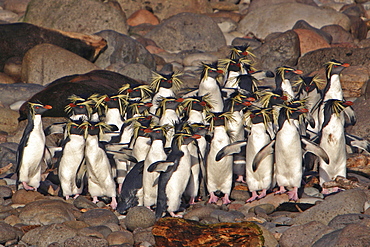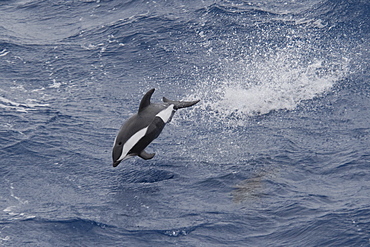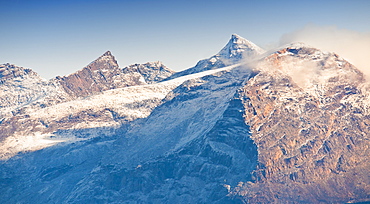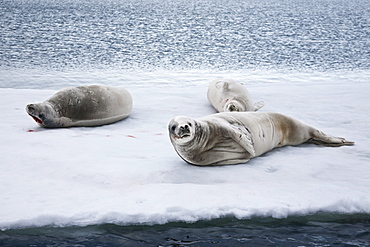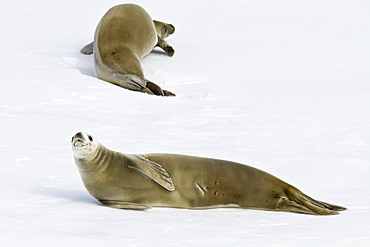Recent searches
Loading...
917-235 - Antarctic Fur Seal mother and pup, Arctocephalus gazella, South Georgia, South Atlantic Ocean.
921-883 - Town views, Pangnirtung, Cape Dyer, Baffin Island, Canada, North America
921-891 - Land mark stone, and view of harbour. Cape Dorset, Baffin Island, Qikiqtaaluk, Nunavut, Canada, North America
921-892 - Night view of town, Cape Dorset, Baffin Island, Qikiqtaaluk, Nunavut, Canada, North America
921-886 - Inuit Mother and baby. Kimmirut, Baffin Island (Qikiqtaaluk) Nunavut, Canada, North America
921-896 - Polar Bear (Ursus Maritimus) bathing in ocean. Akpatok Island, Quebec, Nunavik, Canada, North America
917-276 - Northern Rockhopper Penguins, Eudyptes moseleyi, endangered, endemic to the Tristan Da Cunha island group, taken from a Zodiac at Gough Island (landing is not allowed on Gough Island itself), South Atlantic Ocean.
917-241 - Leucistic Antarctic Fur Seal pup, Arctocephalus gazella, South Georgia, South Atlantic Ocean. Leucism is a general term for the phenotype resulting from defects in pigment cell differentiation and/or migration from the neural crest to skin, hair or feathers . This results in either the entire body surface or patches of the body surface having a lack of cells capable of making pigment.
921-880 - Airplane landing at Pangnirtung, Cape Dyer, Baffin Island, Canada, North America
921-869 - Icebergs, glacier, icefjord. Disko Bay, Ilulissat, Jakobshavn, Qaasuitsup, Greenland (Denmark), North America
917-233 - Bull Southern Elephant Seal, Mirounga leonina, South Georgia, South Atlantic Ocean.
921-881 - Musician Daniel Payne playing fiddle on mountain side. Pangnirtung, Cape Dyer, Baffin Island, Canada, North America
921-885 - Town of Kimmirut, Baffin Island (Qikiqtaaluk) Nunavut, Canada, North America
921-864 - Northern lights, Aurora Borealis, on board the Clipper Adventurer. Kangerlussuaq, Sondre Stromfjord, Greenland (Denmark), North America
917-272 - Hourglass Dolphin, Lagenorhynchus cruciger, Male Dolphin breaching at great speed, Drake Passage, Southern Ocean. Males of this species can be identified by the huge hooked dorsal fin and post-anal keel.
921-865 - Colourful town houses. Sisimiut, Holsteinsborg, Qeqqata Municipality, Greenland (Denmark), North America
921-876 - Mountains surrounding town of Pangnirtung, Cape Dyer, Baffin Island, Canada, North America
921-878 - Pangnirtung, Cape Dyer, Baffin Island, Canada, North America
917-254 - King Penguin chick, Aptenodytes patagonicus, amongst colony, Salisbury Plain, South Georgia, South Atlantic Ocean.
917-256 - Southern Giant Petrels, Macronectes giganteus, flying in unison, Gough Island, South Atlantic Ocean.
917-267 - Flying Fish Species in mid air, scientific name unknown, South Atlantic Ocean.
917-262 - Flying Fish Species in mid air, scientific name unknown, South Atlantic Ocean.
921-897 - Akpatok Island, Quebec, Nunavik, Canada, North America
921-872 - Icebergs and zodiacs in Disko Bay, Ilulissat, Jakobshavn, Qaasuitsup, Greenland (Denmark), North America
917-237 - Antarctic Fur Seal pup, Arctocephalus gazella, portrait, South Georgia, South Atlantic Ocean.
917-275 - Snow Petrel, Pagodroma nivea, flying above icebergs, Weddell Sea, Antarctica.
921-894 - Local inuit man, in freezer house pointing to Polar Bear skins. Kangiqsujuaq, Quebec, Nunavik, Canada, North America .Everything from Arctic Char (fish) to Reindeer, Polarbear and whale meat is stored in the freezer house, in which certain town members can access and store hunted foods and skins. Polar bears often come into the local communities, if one is a persistent threat, they will kill it. Individuals can also hunt polar bears on quota.
921-888 - Harbour seal skins stretched and drying. Kimmirut, Baffin Island (Qikiqtaaluk) Nunavut, Canada, North America
917-245 - King Penguin, Aptenodytes patagonicus, courting behaviour, South Georgia, South Atlantic Ocean.
921-890 - Local Inuit boy, carving from granite a polar bear. Cape Dorset, Baffin Island, Qikiqtaaluk, Nunavut, Canada, North America
921-874 - Mountains surrounding town of Pangnirtung. Cape Dyer, Baffin Island, Canada, North America
917-240 - Leucistic Antarctic Fur Seal pup, Arctocephalus gazella, amongst normally coloured animals, South Georgia, South Atlantic Ocean. Leucism is a general term for the phenotype resulting from defects in pigment cell differentiation and/or migration from the neural crest to skin, hair or feathers . This results in either the entire surface or patches of the body surface having a lack of cells capable of making pigment.
917-249 - King Penguin, Aptenodytes patagonicus, displaying, with the mountains of South Georgia in the background, Salisbury Plain, South Georgia, South Atlantic Ocean.
921-866 - Local Inuit performing Kayak demonstration in arctic water. Sisimiut, Holsteinsborg, Qeqqata Municipality, Greenland (Denmark), North America
917-264 - Pantropical Spotted Dolphin, Stenella attenuata, breaching with small Remora attached, Island of Saint Helena, South Atlantic Ocean.
917-260 - Flying Fish Species, scientific name unknown, South Atlantic Ocean.
921-867 - Ilulissat Harbour, with icebergs. Ilulissat, Jakobshavn, Greenland (Denmark), North America
917-269 - Short-beaked Common Dolphin, Delphinus delphis, surfacing, Costa Rica, Pacific Ocean.
917-244 - Southern Giant Petrel, Macronectes giganteus, South Georgia, South Atlantic Ocean.
917-252 - King Penguins, Aptenodytes patagonicus, with the mountains of South Georgia in the background, Salisbury Plain, South Georgia, South Atlantic Ocean.
979-6987 - Northern (Steller) sea lion (Eumetopias jubatus) on navigational buoy just outside Petersburg in Southeastern Alaska, USA
979-7080 - Wandering albatross (Diomedea exulans) on the wing at sunset approaching South Georgia Island, Southern Atlantic Ocean
979-7303 - Adult emperor penguin (Aptenodytes forsteri) on sea ice near Snow Hill Island in the Weddell Sea, Antarctica.
979-7495 - Adult bull with adult female southern elephant seal (Mirounga leonina) on Torgesen Island just outside Palmer Station in Port Arthur, Antarctica
979-7005 - First winter coloration Bonaparte's gull (Larus philadelphia) in flight over the calm waters of Fresh Water Bay on Chichagof Island in Southeastern Alaska, USA. Pacific Ocean.
979-7014 - The Lindblad Expeditions ship National Geographic Sea Bird operating Zodiacs in Southeast Alaska, USA. No property or model release available for this image.
979-7141 - Adult Striated Caracara (Phalcoboenus australis) in aerial display on New Island in the Falkland Islands, South Atlantic Ocean
979-7602 - The Lindblad Expedition Ship National Geographic Explorer operating in Antarctica in the summer months.
979-7254 - Adult emperor penguin (Aptenodytes forsteri) on sea ice near Snow Hill Island in the Weddell Sea, Antarctica.
979-7713 - Chinstrap penguin (Pygoscelis antarctica) in surf conditions at Baily Head on Deception Island, South Shetland Island Group, Antarctica
979-7729 - Antarctic shag (Phalacrocorax (atriceps) bransfieldensis) in foraging group near Paulet Island, Weddell Sea, Antarctica
979-7139 - Chinstrap penguin (Pygoscelis antarctica) chick head detail at colony on Useful Island near the Antarctic Peninsula. There are an estimated 2 million breeding pairs of chinstrap penguins in the Antarctic peninsula region alone, perhaps as many as 7.5 million breeding pairs in all of Antarctica. Their name derives from the narrow black band under their heads which makes it appear as if they are wearing black helmets, making them one of the most easily identified types of penguin. Other names for them are "Ringed Penguins", "Bearded Penguins", and "Stonecracker Penguins" due to their harsh call. They grow to 68 cm (27 in). The average adult weight of a Chinstrap Penguin is 4.5 kg (10 lbs). Weight can range from 3 to 6 kg (6.6-13.2 lbs), with males being slightly larger and weight varying based on where the penguin is in the breeding cycle. Their diet consists of krill, shrimp, and fish. On land they build circular nests from stones, and lay two eggs, which are incubated by both the male and the female for shifts of five to ten days. They can also breed on icebergs, though they prefer non-icy conditions. The chicks hatch after about 35 days, and have fluffy gray backs and white fronts. The chicks stay in the nest for 20?30 days before they go to join a creche. At around 50?60 days old, they moult, gaining their adult plumage and go to sea. The Chinstrap Penguin was first described by German naturalist Forster in 1781. Its specific epithet was often seen as antarctica, however a 2002 review determined the genus Pygoscelis was masculine, and hence the correct binomial name is Pygoscelis antarcticus.
979-6966 - Northern (Steller) sea lion (Eumetopias jubatus) close-up eating a halibut in Southeastern Alaska, USA
979-7270 - Adult emperor penguin (Aptenodytes forsteri) on sea ice near Snow Hill Island in the Weddell Sea, Antarctica.
979-7552 - Exclusive Resorts guests from the Lindblad Expedition ship National Geographic Explorer pose for a photo on the bow
979-7479 - Juvenile kelp gull (Larus dominicanus) in flight near Ushuaia, Tierra del Fuego, Argentina, Southern Ocean
979-7265 - Adult emperor penguin (Aptenodytes forsteri) on sea ice near Snow Hill Island in the Weddell Sea, Antarctica.
979-7053 - Brown Bear (Ursus arctos) fishing for pink salmon near the salmon weir at Pavlof Harbor on Chichagof Island in Southeast Alaska, USA. Pacific Ocean.
979-7811 - Huge tabular icebergs and smaller ice floes in the Weddell Sea, on the eastern side of the Antarctic Peninsula
979-7801 - Sunset in the Weddell Sea, on the eastern side of the Antarctic Peninsula
979-7741 - Gentoo penguins (Pygoscelis papua) in Antarctica, Southern Ocean
979-7412 - Adult female leopard seal (Hydrurga leptonyx) stalking, then killing and eating an adult gentoo penguin in Paradise Bay, Antarctica, Southern Ocean
979-7756 - Gentoo penguins (Pygoscelis papua) porpoising in Antarctica, Southern Ocean
979-7705 - Adelie penguin (Pygoscelis adeliae) near the Antarctic Peninsula, Antarctica.
979-7242 - Adult emperor penguin (Aptenodytes forsteri) on sea ice near Snow Hill Island in the Weddell Sea, Antarctica.
979-7662 - Adelie penguin (Pygoscelis adeliae) near the Antarctic Peninsula, Antarctica.
979-7314 - Inside the abandoned Antarctic research British Base "W" on Detaille Island, Lallemand Fjord, Loubet Coast, Antarctica
979-7160 - Gentoo penguin (Pygoscelis papua) chick in Antarctica
979-7759 - Guests from the Lindblad Expedition ship National Geographic Explorer take the Polar Plunge off ice floe in the Weddell Sea, Antarctica, Southern Ocean
979-7187 - Black-browed albatross (Thalassarche melanophrys) chick on nest at breeding colony on New Island in the Falkland Islands, Southern Atlantic Ocean
979-7613 - A small pod of 8 Type B killer whales (Orcinus nanus) in pack ice near Snow Hill Island Island, Weddell Sea, Antarctica, Southern Ocean
979-7180 - Adult Black-browed albatross (Thalassarche melanophrys) on the wing in the Drake Passage, Falkland Islands, Southern Atlantic Ocean
979-7056 - Brown Bear sow (Ursus arctos) with coy (cubs-of-year) fishing for pink salmon near the salmon weir at Pavlof Harbor on Chichagof Island in Southeast Alaska, USA. Pacific Ocean.
979-7236 - Adult emperor penguin (Aptenodytes forsteri) on sea ice near Snow Hill Island in the Weddell Sea, Antarctica.
979-7465 - Crabeater seal (Lobodon carcinophaga) hauled out on ice floe near the Antarctic Peninsula
979-7064 - Antarctic Fur Seal (Arctocephalus gazella) porpoising near the Antarctic Peninsula, Antarctica, Southern Ocean
979-7252 - Adult emperor penguin (Aptenodytes forsteri) on sea ice near Snow Hill Island in the Weddell Sea, Antarctica.
979-7687 - Adelie penguin (Pygoscelis adeliae) toboggan prints in fresh snow near the Antarctic Peninsula, Antarctica.
979-7532 - Humpback whale (Megaptera novaeangliae) flukes-up dive near the Antarctic Peninsula, Antarctica, Southern Ocean
979-7800 - Huge tabular icebergs and smaller ice floes in the Weddell Sea, on the eastern side of the Antarctic Peninsula
979-6990 - Northern (Steller) sea lion (Eumetopias jubatus) close-up in Southeastern Alaska, USA
979-7063 - Antarctic Fur Seal (Arctocephalus gazella) on the Antarctic Peninsula at Brown Bluff, Antarctica, Southern Ocean
979-7030 - Brown Bear sow (Ursus arctos) with coy (cubs-of-year) fishing for pink salmon near the salmon weir at Pavlof Harbor on Chichagof Island in Southeast Alaska, USA. Pacific Ocean.
979-7422 - Adult female leopard seal (Hydrurga leptonyx) stalking, then killing and eating an adult gentoo penguin in Paradise Bay, Antarctica, Southern Ocean
979-7383 - Curious adult leopard seal (Hydrurga leptonyx) approaches Zodiac near Booth Island, Antarctica, Southern Ocean
979-7379 - Blizzard conditions cause the ocean's surface to begin to freeze in Dahlmann Bay, Antarctica, Southern Ocean. MORE INFO First signs of grease ice as the surface of the sea begins to freeze.
979-7192 - Adult emperor penguin (Aptenodytes forsteri) on sea ice near Snow Hill Island in the Weddell Sea, Antarctica.
979-7365 - Full moon (plus 1 day) rising over icebergs in the Weddell Sea, Antarctica. MORE INFO This moonrise occurred on January 1, 2010, the night after the blue moon full of December 31, 2009.
979-7467 - Crabeater seal (Lobodon carcinophaga) hauled out on ice floe near the Antarctic Peninsula
979-7065 - Antarctic Fur Seal (Arctocephalus gazella) resting inside abandoned machinery at Whalers Bay inside the caldera at Deception Island near the Antarctic Peninsula, Antarctica, Southern Ocean
979-7312 - Inside the abandoned Antarctic research British Base "W" on Detaille Island, Lallemand Fjord, Loubet Coast, Antarctica
979-7292 - Adult emperor penguin (Aptenodytes forsteri) on sea ice near Snow Hill Island in the Weddell Sea, Antarctica.
979-7022 - South Sawyer Glacier in Tracy Arm - Fords Terror Wilderness area in Southeast Alaska, USA.
979-7707 - Chinstrap penguin (Pygoscelis antarctica) colony at Baily Head on Deception Island, South Shetland Island Group, Antarctica
979-7660 - Adelie penguin (Pygoscelis adeliae) near the Antarctic Peninsula, Antarctica.
979-7250 - Adult emperor penguin (Aptenodytes forsteri) on sea ice near Snow Hill Island in the Weddell Sea, Antarctica.
979-7506 - Humpback whale (Megaptera novaeangliae) surfacing near Zodiac near the Antarctic Peninsula, Antarctica, Southern Ocean
979-7106 - Guests from the Lindblad Expedition ship National Geographic Endeavour, Antarctica
979-7403 - Adult leopard seal (Hydrurga leptonyx) hauled out on ice floe near the Antarctic Peninsula, Southern Ocean






